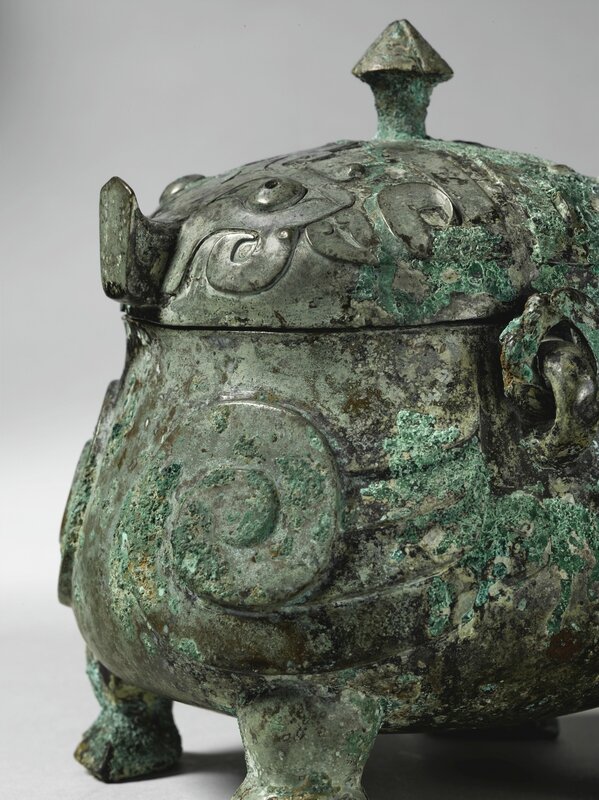A rare bronze double-owl-form ritual vessel (you), Shang Dynasty
Lot 13. A rare bronze double-owl-form ritual vessel (you), Shang Dynasty. Estimate 400,000 — 600,000 USD. Photo: Sotheby's
of oval section in the form of two addorsed owls, their rounded bodies supported on four stout legs, the sides cast in low relief with four wings sweeping back from each rounded breast to a pair of loops attached to the rope-twist swing handle, the domed fitted cover crisply cast on each side with the head of an owl, each with a pair of round protuberant eyes centered on a sharp hooked beak, the heads further adorned with two pairs of hooked ears, all below a segmented bud-shaped finial, the smooth silvery-green patina with malachite encrustation, the interior of the vessel with a single pictogram, Japanese wood box (4) - Height with handle 6 3/4 in., 17.1 cm
Provenance: Collection of J. Eguchi, Osaka.
Exhibited: Kodai Chugoku Seidouki Meihin ten [Exhibition of Ancient Chinese Bronzeware Masterpieces], Daimaru Department Store, Osaka, 1960, cat. no. 7.
Toyo Kan Kaikan Kinen Toyou Bijutsu Ten / Exhibition of Eastern Art Celebrating the Opening of the Gallery of Eastern Antiquities, Tokyo National Museum, 1968, cat. no. 240.
Literature: Rong Geng, 'Shang Zhou yiqi tongkao [The bronzes of Shang and Zhou]', Yenching Journal of Chinese Studies, vol. II, no. 17, 1941, p. 337, fig. 647.
Sueji Umehara, Nihon shucho Shina kodo seikwa / Selected Relics of Ancient Chinese Bronzes from Collections in Japan, vol. 1, Osaka, 1964, pl. 41.
Minao Hayashi, Inshu Jidai Seidoki no Kenkyu [Studies on Shang and Zhou Period Bronzes], Tokyo, 1986, pl. 287, fig. 7.
Notes: You vessels of double-owl form are generally known in two types: those with extensive surface decoration, and those with plain surfaces such as the present example. Two related vessels, one in the Hubei Yingxing Wenhua Guancang and the other in the Shanghai Museum, are illustrated in Zhongguo qingtongqi quanji, vol. 4, Beijing, 1998, pls 156 and 157 respectively; and another is included in Robert W. Bagley, Shang Ritual Bronzes in the Arthur M. Sackler Collections, Washington DC., 1987, pl. 63, where the author discusses the development of this vessel type from the naturalistic to more abstract forms: ‘the beaks have become inorganic projections that belong to the lid rather than the owls and the metamorphosis of the owl’s head into a taotie face is complete’ (see p. 370). Two further vessels of this type were sold in these rooms, 20th March 2012, lot 13, and 21st September 2005, lot 157.
A related vessel with similar abstract swirl design, but without a handle, in the Asian Art Museum of San Francisco, San Francisco, is illustrated in Rene Lefebvre d’Argence, Bronze Vessels of Ancient China in the Avery Brundage Collection, San Francisco, 1977, pl. XV; another, in the Shanxi Provincial Museum, is published in Zhongguo qingtongqi quanji, vol. 4, Beijing, 1998, pls 154-55; and a third example was sold at Sotheby’s New York, 5th April 1956, lot 45, and again in these rooms, 15th/16th September 2015, lot 104. Compare also a double-owl you without handle, cast in its natural form with hooked beak, flat ears and plump body, its breast and wings covered with feather-like patterns, in the Freer Gallery of Art, Washington D.C., published in Robert W. Bagley, op. cit., p. 371, fig. 63.4.
Among the many animal motifs used in early Chinese art, the representation of the owl is one of the most prominent yet mysterious images. As early as the Yangshou culture (c. 5500-3500BC), potters were clearly fascinated by this bird and created various representations of it. Jade carvings of small owl-like birds at sites of the Hongshan culture (c. 4000-3000BC) in northeast China in tombs of community chiefs or religious figures suggest they were part of the religious system. During the final phase of the Shang dynasty (c. 1300-1046BC), its capital was moved to Yinxu (present day Xiaotun in Anyang, Henan province), where bronze manufacturing reached its peak under royal patronage. With the developing knowledge of and skills in metal working came remarkable innovations in bronze production. Many new types of vessels were introduced and increasingly sophisticated schemes were applied to the surface decoration.
The terrifying screech and nocturnal behaviour of the owl would have perfectly suited the archaic perception of abnormality in ritual and magic, while its physical appearance is reminiscent of a warrior. It is thought that the mythical blackbird (xuanniao) from which the Shang people were believed to have originated was an owl, and that the mythical ancestor Di Jun can be identified with the bird deity who was also the agriculture protector and solar god for the Shang people. For further details on the owl in early China, see Wang Tao, ‘The Owl in Early Chinese Art: Meaning and Representation’, Chinese Art through the Eye of Sakamoto Goro. A Bronze Owl Hu, Sotheby’s New York, 18th March 2014, pp 24-28.
According to some scholars, the main decorative motifs on Shang bronzes are concerned with metamorphosis. As Wu Hung notes in Monumentality in Early Chinese Art and Architecture, Stanford, 1995, p. 48, the taotie motif often combines features from different animals which never become naturalistic representations or formulated icons. Instead, ‘these varying images seem to attest to a painstaking effort to create metaphors for an intermediate stage between the supernatural and reality – something that one could depict but not portray’ (see p. 53). Many Shang bronzes were clearly inspired by the owl motif, either in the form of a vessel or as surface decoration. For example, a fangjia, formerly from the collection of the Albright-Knox Gallery, sold in these rooms, 19th/20th March 2007, lot 507.
Sotheby's. Chinese Art Through the Eye of Sakamoto Gor: Early Chinese Art, New York, 13 Sep 2016, 10:00 AM

/https%3A%2F%2Fprofilepics.canalblog.com%2Fprofilepics%2F1%2F0%2F100183.jpg)
/https%3A%2F%2Fstorage.canalblog.com%2F03%2F02%2F119589%2F96711876_o.jpg)
/https%3A%2F%2Fstorage.canalblog.com%2F11%2F31%2F119589%2F94773502_o.jpg)
/https%3A%2F%2Fstorage.canalblog.com%2F20%2F83%2F119589%2F94772815_o.jpg)
/https%3A%2F%2Fstorage.canalblog.com%2F26%2F72%2F119589%2F75604929_o.jpg)
/https%3A%2F%2Fstorage.canalblog.com%2F59%2F60%2F119589%2F26458628_o.jpg)








/image%2F1371349%2F20240406%2Fob_b23648_434058570-1644317966338216-88086167391.jpg)
/image%2F1371349%2F20240403%2Fob_6d5ae7_dp-28103-001.jpg)
/image%2F1371349%2F20240229%2Fob_8f31f9_431013694-1625286614908018-33034430839.jpg)
/http%3A%2F%2Fstorage.canalblog.com%2F79%2F20%2F119589%2F129837997_o.jpg)